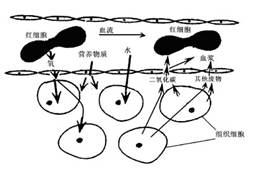下图是人体血液与组织细胞之间的物质交换示意图,请根据图回答下列问题:

(1)图中红细胞中的氧来自于外界空气,空气中的氧在人体肺的 处进入血液,并与红细胞中的_____________ 结合,随血液循环到达组织细胞处,因此,红细胞具有运输氧的功能。
(2)图中血液里的营养物质主要来自于食物,食物在消化道内被消化成可以吸收的营养物质,这些物质主要在______________ 处被吸收进入血液。
(3)组织细胞产生的二氧化碳和其他废物通过毛细血管壁进入血液,血液里的这些废物主要由泌尿系统以尿的形式排出,尿液的主要成分有 等。
(4)按图中血液流动的方向,此处毛细血管流出的血液应该是 ,原因是: 。
(1)毛细血管,血红蛋白。(2)小肠绒毛。(3)水,无机盐,尿素。(4)动脉血,含氧气和营养物质丰富
题目分析:(1)红细胞里有一种红色含铁的蛋白质,叫血红蛋白,血红蛋白的特性是在氧含量高的地方,与氧容易结合,在氧含量低的地方,又与氧容易分离,血红蛋白的这一特性,使红细胞具有运输氧的功能,外界空气中的氧气,通过吸气运动进入肺泡后扩散到血液里,与红细胞里的血红蛋白结合后,随血液循环到达组织细胞处。
(2)小肠是吸收营养物质的主要场所,这是与小肠的结构特点相适应的:小肠长约5~6 m,小肠内壁有环形皱襞,皱襞上有小肠绒毛,增大了吸收的面积,小肠绒毛内有毛细血管和毛细淋巴管,绒毛壁、毛细血管壁、毛细淋巴管壁都佷薄,只由一层上皮细胞构成的,有利于营养物质的吸收,因此食物在消化道内被消化成可以吸收的营养物质后主要在小肠处被吸收。
(3)尿的形成过程是:当血液流经肾小球时,除了血细胞和大分子的蛋白质外,血浆中的一部分水、无机盐、葡萄糖和尿素等物质,都可以经过肾小球滤过到肾小囊内,形成原尿,当原尿流经肾小管时,其中对人体有用的物质,包括大部分水、全部葡萄糖和部分无机盐,被肾小管重新吸收,并且进入包绕在肾小管外面的毛细血管中,重新回到血液里,原尿中剩下的其他废物,如尿素、一部分水和无机盐等由肾小管流出,形成尿液,因此尿液的主要成分是水、无机盐、尿素。
(4)图示中的毛细血管为组织处毛细血管,在这里,血液与组织细胞进行物质交换:将运来的营养物质和氧气供给细胞利用,将细胞产生的二氧化碳等废物带走,这样,血液就由动脉血变成了静脉血。
点评:此题涉及的知识面较广,包括了血液与组织细胞的物质交换、营养物质的吸收、红细胞的功能、尿的形成等知识,有一定的难度,解答此题的关键是掌握这些知识。
